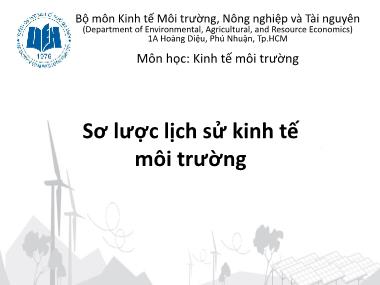Bài giảng Kinh tế môi trường - Chương 2: Sơ lược lịch sử kinh tế môi trường
An eighteenth century forerunner:
Marquis de Condorcet (1776)
▪ Awareness of the links between economic
activity and environmental quality.
▪ A pioneer in the use of externality arguments
for policy analysis of environmental policy (i.g.
forbidding harmful economic activities,
restricting property rights, undertaking public
works)
Bạn đang xem tài liệu "Bài giảng Kinh tế môi trường - Chương 2: Sơ lược lịch sử kinh tế môi trường", để tải tài liệu gốc về máy hãy click vào nút Download ở trên
Tóm tắt nội dung tài liệu: Bài giảng Kinh tế môi trường - Chương 2: Sơ lược lịch sử kinh tế môi trường

Sơ lược lịch sử kinh tế môi trường Bộ môn Kinh tế Môi trường, Nông nghiệp và Tài nguyên (Department of Environmental, Agricultural, and Resource Economics) 1A Hoàng Diệu, Phú Nhuận, Tp.HCM Môn học: Kinh tế môi trường Nội dung 1. Giai đoạn trước 1960 2. Giai đoạn sau 1960 ▪ Sandmo (2015). The early history of environmental economics. Review of Environmental Economics and Policy, Vol.9: 43-63. Giai đoạn trước 1960 An eighteenth century forerunner: Marquis de Condorcet (1776) ▪ Awareness of the links between economic activity and environmental quality. ▪ A pioneer in the use of externality arguments for policy analysis of environmental policy (i.g. forbidding harmful economic activities, restricting property rights, undertaking public works). ▪ However, public intervention was based on social justice, not efficiency. The classical school: From Smith to Mill ▪ Adam Smith (1776): Theory of the invisible hand, and the provision of public goods through government action. ▪ Thomas Malthus (1798): Theory of population provided inspiration for later economists to grapple with the issue of resource scarcity and economic development. ▪ David Ricardo (1817): Theory of land rent regarding both agriculture and mining became of great importance for future development of environmental economics. ▪ John Mill (1848) emphasized the public nature of the natural environment and the tasks of the government; and expressed strong support for preserving the natural environment. ▪ Perspectives on the classical economists: An early awareness of the environmental problems and a belief that public policy could improve the market outcome. The classical school: From Smith to Mill Practical applications: Edwin Chadwick (1800 – 1890) ▪ A civil servant (not economist) was much influenced by the utilitarian philosopher Jeremy Bentham and John S. Mill. ▪ Utilized classical price theory (incentive- based mechanisms) to design incentives for environmental and social improvement. Natural resource scarcity: William Jevons and the coal question ▪ The lack (depletion) of coal would act as a brake on the country’s economic growth. ▪ He explicitly linked the present and future price of coal to the cost of extraction. ▪ It is just possible that some day the sunbeams may be collected, or that some source of energy now unknown may be detected (Jevons, 1865). The marginalist revolution and the evironment ▪ Alfred Marshall (1890): Initial formulation of externality concept. He realized that in the presence of externalities, the market equilibrium will no longer be socially efficient. ▪ Marshall’s effort on fisheries pioneers the study the economics of a common property resource. Arthur Pigou (1920) and the foundations of environmental economics ▪ Further developed the theory of externalities. ▪ Analyzed how the choice of policies, particularly taxes, could improve the efficiency of resource allocation. ▪ Discussed the empirical measurement of environmental damage. ▪ Called for subsidies to afforestation as an instrument for global climate policy. ▪ Suggested other policy options like prohibition of the production and consumption. The emergence of natural resource economics ▪ Scott Gordon (1954). The economic theory of a common-property resource: The fishery. Journal of Political Economy, Vol.62. ▪ Harold Hotelling (1931). The economics of exhaustible resources. Journal of Political Economy, Vol. 39. Paul Samuelson (1954) and the theory of public goods ▪ The environmental benefit-cost analysis is the practical application of the fundamental ideas in the theory of public goods. ▪ Pearce (2002). An intellectual history of environmental economics. Annu. Rev. Enery Environ, Vol. 27: 57-81. - The establishment of RFF (resources for future) organization in 1952 - Silent Spring by Rachel Carson in 1962 - Material balance model by Robert Ayres and Allen Kneese 1969 - Property rights and transaction costs by Ronald Coase 1960 Giai đoạn sau 1960 ▪ The strategy of the commons by Garrett Hardin ▪ Passive use value by Krutilla 1967 ▪ Polluter pays principle by OECD 1972 ▪ Marketable permits by John Dales 1968 Giai đoạn sau 1960
File đính kèm:
 bai_giang_kinh_te_moi_truong_chuong_2_so_luoc_lich_su_kinh_t.pdf
bai_giang_kinh_te_moi_truong_chuong_2_so_luoc_lich_su_kinh_t.pdf

